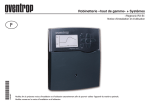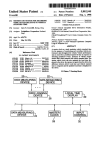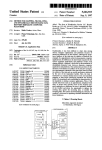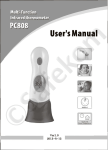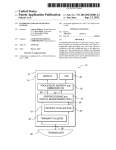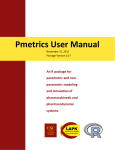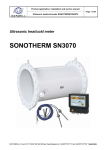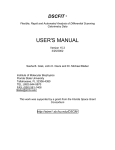Download Calorimetric RF power meter with dynamic zeroing and constant
Transcript
USOO566363 8A United States Patent [19] [11] Patent Number: 5,663,638 Humpherys [45] Date of Patent: Sep. 2, 1997 [57] [54] CALORIM'ETRIC RF POWER METER WITH DYNAMIC ZEROING AND CONSTANT TEMPERATURE AND POWER DISSIPATION IN THE CALORIMETRIC BRIDGE The etl'ects of di?erential heating inside the calorimetric bridge are reduced by ?rst heating the bridge externally and controlling the resulting temperature. The bridge is also heated internally by an amount that varies according to the applied power to be measured. This acts to eliminate the principal source of thermal gradients in the ?rst instance. By applying this heat as a common mode input signal to the two [75] Inventor: Melvin D. Humpherys. Spokane. Wash. [73] Assignee: Hewlett-Packard Company. Palo Alto. terminating loads of the calorirnetric bridge the bridge itself Calif. does not become unbalanced. and therefore does not attempt to measure that common power. Actual input power to be Appl. No.: 681,564 Filed: ABSTRACT measured does initially unbalance the bridge. and is still measured as usual. A constant power circuit is response to the indication of measured power and acts to keep the sum Jul. 29, 1996 Int. Cl.6 .......................... .. 601R 21/02; 601R 19/03 of measured power (plus the equal amount of feedback US. Cl. ........... .. 324/95; 324/106 power that balances the bridge) and the common mode Field of Search .............................. .. 324/95. 96. 105. power at a constant value corresponding to a full scale 324/106; 455/61.1-67.1. 2261-2264. 115 measurement. This eliminates internal thermal transients within the bridge that lengthen response time. The feedback signal to balance the calorimetric bridge is produced by an integrator. To allow operation of the integrator output closer References Cited to zero for measurement of small applied signals. the applied input to be measured is periodically removed and a suitable slight otfset from the true balance condition is introduced into the servo loop. The bridge is then exactly balanced with a separate sample and hold control loop. “Periodically” can U.S. PATENT DOCUMENTS 3,665,322 3,845,388 5/1972 Julie ...................................... .. 324/106 10/1974 Ley et a1. .. .... .. 324/106 3,928,800 12/1975 Strenglein 324/106 mean once a second. ten times a second. or as is preferred. Primary Examiner-Ernest F. Karlsen Assistant Examiner-Anh Phung Attorney Agent, or Fimt-EdWard L. Miller , , ; 9WD ; -|— POWER Ti m ._.".__ : S H73 f‘ 5O W I 58 32 g 6 Claims, 5 Drawing Sheets FlNE STATIC BALANCE __________________ _~ ACTUAL SLOW at the start of each measurement. (47 on], 5 kHz 34 r 51s 36 DAC __—__—-€ (y) INTEGRATOR ANALOG 46 MULTIPLIER 70 _| S 49 | m 30 mm ' 35 5 40 71 m B "'3' A 41 ' T °_AL3§,1§‘§ETR‘¢ »' I’ SUBSTRATE . : An - _ FILTER 81 s2 S 43 ‘ """" “ BUAFMEPER T E * 4B DETECTOR 484 as i i 455 : INTEGRATOR ' i T BUFFER 55 SLOW mm POWER CIRCUIT AMP SYNCHRONOUS | 515366 TN _’ \_ COMPARISON DELTA POWER 74 l LOG i , g ....................... f ‘‘‘‘ “Te-25 kHz : —--4 : : X I:61 REF : 400g _______________ '7 F72 LOW PASS 42 i 58 + POWER~/‘9 ggé??gmm ADC 84 27*’ AMP [53 ‘ 5 SLIGHT OFFSET 54 A r61 R<~ SUBSTRATE TEMPERATURE 0<— CONTROLLER 0< US. Patent Sep. 2, 1997 % 2:5<53E: Sheet 5 of s 5,663,638 75 \v COMPARISON SLOW POWER IN (57) FIG. 5A 77 w 78 (76 COMPARISON SLOW POWER m (57) FIG. 5B NON LINEAR FEED BACK f 74 COMPARISON SLOW POWER IN /> DELTA POWER > S 57 FIG. 5C 5,663,638 1 2 CALORIMETRIC RF POWER METER WITH DYNAMIC ZEROING AND CONSTANT TEIVIPERATURE AND POWER DISSIPATION IN THE CALORIMET'RIC BRIDGE be desirable if this need for thermal time constant response time could be eliminated. A control loop can use an ampli?er or an integrator to form the feedback signal. In many situations where a small change is to be measured and a DC measurement technique is prone to unacceptable drift. it is advisable to shift to AC measurement techniques. In these cases a synchronous detector coupled to an integrator form an attractive combi REFERENCE TO RELATED APPLICATION The subject matter of this application is related to what is disclosed in US. Pat. application Ser. No. 08/548.067 entitled METHOD AND APPARATUS FOR MEASURING RF POWER INATEST SET. ?led on 25 Oct. 1995 pending by Melvin D. Humpherys and assigned to Hewlett-Packard Co. US. patent application Ser. No. 081548.067 is hereby nation for forming the actual feedback signal from the 10 power measurement technique. the integrator output is used to produce heat. then either polarity of output from the integrator can cause a point of balance. However. one expressly incorporated herein by reference. BACKGROUND OF THE INVENTION 15 Developments in semiconductors in the last decade or so and recent changes in the allocation of portions of the radio frequency spectrum have contributed to the vigorous growth to zero. even when the bridge is actually balanced. As a needed. repaired and tested. The advent of spread spectrum technologies. such as CDMA in the United States and GSM included in the test equipment. to allow that aspect of the performance of the device under test to be evaluated. Such 25 bridge is indeed balanced. SUMMARY OF THE INVENTION separate instruments need not apply . . . ) as well as 30 adaptable to future developments. Among the things that such a test set has to do is measure RF power. The power measurement module of such a test set ought therefore to be small. accurate. broad band. suitable power into a terminating load. and thermally couples the heat generated to a temperature dependent resistance that is does not attempt to measure that common power. Actual input power to be measured does initially unbalance the 45 meters of this sort have been known for some time. See for eliminates internal thermal transients within the bridge that lengthen response time. Journal entitled “Microprocessor-Enhanced Performance in of the components within the bridge can be trimmed into balance. they still have temperature coe?icients. and it is exceedingly di?icult to control the thermal paths within the physical part. The result is that under a thermal gradient. such as the application of power to be measured. the bridge can become unbalanced owing to an unsymmetrical bridge. and is still measured as before. A constant power circuit is response to the indication of measured power and acts to keep the sum of measured power (plus the equal amount of feedback power that balances the bridge) and the common mode power at a constant value corresponding to a full scale measurement. or perhaps even a little more. This example. the Operating and Service Manual for the Hewlett Packard Model 434A Calorimetric Power Meter (circa 1961). A more recent example of this technique can be found in an article on page 26 of the July 1987 Hewlett-Packard The accuracy of calorimetric bridges is affected by temperature. and especially by temperature diiferentials occurring across the bridge. Even though the electrical value A second solution to the problem of differential heating is to heat the bridge internally by an amount that varies according to the applied power to be measured. This acts to eliminate the principal source of thermal gradients in the ?rst instance. By applying this heat as a common mode input signal to the two terminating loads of the calorimetric bridge the bridge itself does not become unbalanced. and therefore one arm of a bridge. This unbalances the bridge and pro duces an error signal within a servo loop. The servo responds by applying DC or low frequency power to a separate but an Analog Power Meter". A solution to the problem of differential heating inside the calorimetric bridge is to first heat the bridge externally and control the resulting temperature. An actual insulated oven could be used if desired. although it may be su?‘icient to rely upon a heated thermal mass without insulation. 35 and poses a signi?cant challenge to the designers of a test set to be used with radio equipment such as cellular telephones. A calorimetric RF power meter is a device that accepts RF identical terminating load whose heat is coupled to another arm of the temperature sensitive bridge. The applied power is measured by metering how much power is required of the servo loop to rebalance the bridge. Calorimetric RF power complication to the logic of the servo loop. that brute force solution is indeed manageable. but it can nevertheless have the disadvantage of limiting the accuracy with which small signal levels can be measured. It would be desirable if this limit on dynamic range could be eliminated by allowing the integrator output to operate much closer to zero when the test equipment ought to be reliable and relatively compact (those wishing to sell systems comprising a rack full of for pulse modulation applications in addition to CW. and. inexpensive. That is quite a list of disparate requirements. polarity has associated therewith the wrong logical sense of change as between the feedback signal and the error signal. If the system gets into that state the feedback is not longer negative. but becomes positive. As a result. it is generally necessary to anticipate a worst case of margins and then prevent the integrator output from getting within that close in the uses and markets for various portable transceivers. such as used in cellular telephone swim and GMRS. That which is to be manufactured must also be tested and. as in Europe. require that additional levels of sophistication be ampli?ed error signal. If. as in the case of a calorimetric 55 A solution to the problem of being unable to operate the integrator output su?iciently close to zero is to periodically remove the applied input and introduce into the servo loop a suitable slight offset from the true balance condition. and then exactly balance the bridge with a separate sample and hold control loop. “Periodically” can mean once a second. ten times a second. or as is preferred. at the start of each measurement. BRIEF DESCRIPTION OF THE DRAWINGS FIG. 1 is a simplified block diagram of a test set for radio communication equipment. such as cellular telephones and response of the bridge itself to the thermal gradient. In time. if steady state conditions are maintained. the gradient will GMRS transceivers. and that includes an RF power mea level out and an accurate answer will be available. It would with the invention; surement capability constructed and operating in accordance 5,663,638 3 4 FIG. 2 is a an expanded yet still simpli?ed block diagram of an RF power measurement portion of the test set FIG. 1; FIG. 3 is an expanded block diagram. for a portion of the block diagram of FIG. 2. representing a calorimetric RF power meter that includes dynamic zeroing and constant temperature and power dissipation in the calorimetric RF power from the DUI‘ 2 is coupled by line 18 and coupler bridge; 4 to a gain stage 20 whose gain may be set to a convenient amount. which includes zero. The signal from the gain stage 20 is applied to a switch 21. When the switch 21 is thrown 5 20) connected to a test port. This facilitates test and cali bration of the test set itself. The switch 21 may also be set to position 23. which couples the DUT to a “fast” power . FIG. 4 is diagram indicating certain aspects of operation measurement module 25 that uses a diode power sensor. The that are of interest for the calorimetric RF power meter of response time of the “fast” power measurement module 25 is in the microseconds and its output information 27a is made available as a part of POWER MEASUREMENT RESULTS 9. as well as being applied as an input to an auto range controller 28. The output of the auto range controller FIG. 3; and FIGS. SA~C are diagrams describing a constant power circuit shown in the block diagram of FIG. 3. DESCRIPTION OF A PREFERRED EMBODIMENT Refer now to FIG. 1. wherein is shown a simpli?ed block diagram 1 of a test set for use with radio communication equipment. such as cellular telephones and GMRS trans ceivers. A DUI‘ 2. or Device Under Test. represents the radio communication equipment to be tested. In this particular test set 1 there are two signal generators l0 and 11 and two receivers 13 and 14. Of the two receivers. receiver #1 I3 is coupled to various measurement circuits that provide mea to position 22 the output of the DUT is (via the gain stage 28 is used to set the gain of the gain stage 20. The embedded control system periodically sets switch 21 to position 23 expressly so that the gain of gain stage 20 may be set to a value that places the output power level of the gain stage 20 within the dynamic range of the “slow” power measurement module 26. It will be understood. of course. that the “fast” power measurement module 25 can also be used to perform primary power measurements on the DUT whenever a fast response is required; e.g.. pulsed power measurements. sured data called RECEIVER RESULTS 15. The operation ‘Those interested in more information about what is in the fast power measurement module 25 may ?nd it instructive to of the receivers (13. 14) and signal generators (10. 11) is controlled by a protocol generation and recognition machine 08/548,067. 17. This is principally an embedded microprocessor con trolled system that interacts on the one hand with an operator arrangement that obtains when switch 21 is set to position through a display and control panel (not shown) or with external controller such as another computer system (not shown) to select or specify the type of measurement or test to be performed. and on the other hand with the internal resources of the test set (e.g.. the signal generators 10 8: 11 and receivers 13 & 14) to set up and perform those mea surements and tests. An important task of the protocol generation and recognition machine 17 is the ability to take into account the speci?c properties and behaviors that make up the various standards by which the radio communication consult the aforementioned patent application Ser. No. To continue. we shall ?nd it convenient to dwell on the 30 measurement module 26 whose power sensor is a calori men'ic bridge. The output of the “slow" power measurement module 26 is information 27b that is part of the POWER 35 Now consider the block diagram shown in FIG. 3. What is shown is a simpli?ed block diagram of the “slow" power measurement module 26. At the upper left of the block diagram is the input signal ACTUAL SLOW POWER IN 30. while at the lower right appears the output signal 27b that is part of POWER MEASUREMENT RESULTS 9. We are interested now in what goes on inbetween these two signals. ter and power combiner to allow simultaneous access to the 45 DUT 2 by the signal generators 10 and 11 and by the receivers 13 and 14. This action is represented schematically by individual components 5. 6 and 7. We shan’t have much power present in the path 18 connecting the combiner] splitter element 5 to the DUT 2. To this end. note sampler 4. which may be a suitable directional coupler. which extracts a signal. say. 20 db below that present in line 18 and applies it to a power measurement module 8 whose output may be called POWER MEASURE MENT RESULTS 9. POWER MEASUREMENT RESULTS 9 may be taken with RECEIVER RESULTS 15 as comprising the raw measurements of the performance of the DUT 2. These measurements are interpreted by the protocol generation and recognition machine 17. Refer now to FIG. 2. wherein is shown in block diagram form 19 an expansion of the power measurement module 8. The input signal ACI‘UAL SLOW POWER IN 30 is applied to a calorimetric bridge substrate 31 that includes a 509 terminating resistor 32 that is closely thermally coupled to a sensing resistor 35 whose resistive value has a signi? cant dependence upon temperature. Sensing resistor 32 is in more to say about the elements 5. 6 and 7 in combiner] separator 3. save that they must provide certain desirable MEASUREMENT RESULTS 9. Our interest is primarily in certain aspects of the operation and construction of the “slow" power measurement module 26. equipment is to operate, such as CDMA and GSM. That said. it will be appreciated that a signal combiner! separator 3 couples the DUT 2 to the various signal gen m'ators and receivers in the test set 1. Principally. the combiner/separator 3 functions as a specialized power split isolation between various ones of the DUT and the signal generators and receivers. must not be lossy. and must be fairly broad band (say. ?at from below 50 MHz to above 2 GHZ). Our present interest is in the measurement of RF 24. In such a case we shall say that the signal ACTUAL SLOW POWER 30 is coupled to the input of a “slow” power 50 series with a load resistor 34. and forms a voltage divider therewith. Areference signal generator 46 produces a 5 KHz signal 47 that. among a number of other places. is applied to the top of the voltage divider formed by resistors 34 and 35. Thus. the amplitude of the 5 KHz signal 49 at the tap of the 55 voltage divider is (principally) determined by the amount of power being dissipated in terminating resistor 32. Now observe the signal COMPARISON SLOW POWER IN 57. It is a DC or low ?'equency signal applied to a 500 resistor 33 identical to resistor 32. Resistor 33 is closely thermally coupled to a sensing resistor 37 identical to sensing resistor 35. Resistor 37 is also in series with a load resistor 36 identical with load resistor 34. so that resistors 36 and 37 form a voltage divider corresponding to the voltage divider formed by resistors 34 and 35. The voltage divider formed by resistors 36 and 37 is also occupied at its top to the 5 X112 reference signal 47. Ideally. the amplitude of the signal 41 produced at the tap of this second voltage divider 5,663,638 5 6 will equal that of the signal whenever power level of the That is. what we really seek is the measured power when power is applied minus any residual “measured power” signal COMPARISON SLOW POWER IN 57 is the same as that ACTUAL SLOW POWER IN 30. It is the job of the circuitry inbetween the two signal 30 and 57 to servo signal 57 to match signal 30 by nulling to zero the di?’erence between signals 40 and 41. That done. the power level of signal 30 can be inferred by a direct measurement of the amplitude of signal 57. and the knowledge that resistor 33 is 509. Along the way however. there arise some signi?cant opportunities for error. To continue. the calorimetric bridge substrate 31 is a when power is not applied. Of course. the residual measured power does not represent real power. but drift or other imbalance in the system. One of these imbalances concerns the operating point of the main servo loop when there is indeed no power applied. Let’s assume for a moment that the system is truly ideal. Then. for zero RF in signals 40 and 41 are exactly equal. and the error signal all around the loop would be zero. In particular. the output of integrator 52 would be zero. Now. if there were just a slight amount of power applied to the ACI‘UAL SLOW POWER IN 30. the error signal from error uni?ed assembly fabricated using thin ?lm and integrated circuit techniques. The 50!! resistors 32 and 33 are formed of meandering titanium traces. for example. and the entire assembly 31 is packaged up in its own little can. It is not. however. a part that was speci?cally designed for this particular application. It was designed to be an RF power 15 back into balance. If the integrator overshot. or the actual input power level decreased. the synchronous detector 45 sensor. to be sure. but for us happens to be an already would reverse the sign of the recti?ed error signal. and the existing part whose speci?cations and tolerances were selected to suit an earlier application. For reasons of ampli?er 42 would be recti?ed and produce. say. a positive signal to apply to integrator 52. In turn. it would produce a positive going ramp that would eventually bring the loop 20 economy. it is desirable to take advantage of this existing part. and ?nd a way to live with certain “shortcomings” that result. (It is not that the part is a “bad” part; it is more that if we were designing it for the ?rst time we would change integrator would ramp back down. The sign of the integrator output would still be positive. however. Now. in a real system there are always imbalances and offsets. however small. This means that the loop will come into balance with a slight integrator output. Absent the need some things to be more appropriate to our intended use. 25 to measure applied power. that quiescent state of slight Even if we did. however. issues we are about to explore do integrator output could as easily be a slight negative output; after all. that would still produce power in resistor 33 that ought to balance the loop. Heat is heat. Ah. but what then of the logical sense of the control signal? If the loop overshoots not altogether vanish.) So. let us ?rst describe the overall servo loop that nulls the diiference between signals 40 and 41 by adjusting the power level of signal 57. That done. we can return to a description 30 the polarity of the signal from the synchronous detector 45 would still be negative. which would drive the output of the of the “shortcomings” and what to do about them. To begin. then. note that signals 40 and 41 are coupled to a difference ampli?er 42 whose output is applied to a low pass ?lter 43. The main purposes of the low pass ?lter 43 are to assist in setting the dynamic behavior (step response) of 35 integrator 52 still more negative. further adding to the overshoot. In other words. the logical sense of the control signal has been reversed. The result is that the servo drives itself to the rail. and locks up. Clearly. this mode of operation the servo loop and to suppress harmonics of the ampli?ed error signal. The output of the low pass ?lter 43 is coupled to a log ampli?er 44. whose output is in turn applied to a must be avoided. As a practical matter. this means that actual operational “zero point" of the loop must not be set so close to the actual zero crossover of the integrator that noise. drift synchronous detector 45. The synchronous detector 45 oper ates to rectify the ampli?ed 5 KHz error signal; the resulting DC signal has a polarity indicative of whether COMPARI or other loss-of-margin conditions inadvm‘tently pushes the servo system over the edge. Absent some better mechanism. the brute force accommodation for this situation is to simply put the operational zero point at what is really the ten percent SON SLOW POWER IN 57 is too high or too low. and is applied via switch 48 to either an integrator 49 during an instance of dynamic zeroing. or to an integrator 52 at other point in the safe operating region. This works. but uses up dynamic range and make the measurement of low power times. Integrator 52 responds to the continued presence of a 45 levels less accurate. Reference to FIG. 4 will be useful at this point. FIG. 4 is recti?ed error signal by ramping its output up or down until a graph 62 of the COMPARISON SLOW POWER 1N along the recti?ed error signal vanishes. During these “other abscissa 64 needed to null the servo loop for different times” (i.e.. during power measurement) the output of the mounts of ACTUAL SLOW POWER 1N along ordinate 65. integrator 52 is coupled via switch 55 to a bu?’er ampli?er 56. which may be a unity gain ampli?er. It supplies the heft 50 Because of the symmetry of the calorimetric bridge 31. the slope of the resulting line in the graph is one; ten milliwatts needed to drive the relatively low impedance of the 500 of comparison signal 57 balances ten milliwatts of input resistor 33. It will further be appreciated that bulfer ampli?er signal 30. Thus. line 63 is depicted as being at forty-?ve 56 might be replaced by an analog multiplier circuit 82 degrees to the axes. Range 67 would be the ideal range over whose two inputs were the output of the integrator 52 via switch 55 and a low frequency AC signal 83 (say. 25 I612). 55 which the loop would operate if there were no concerns about the output of the integrator 52 going negative. In this way the signal COMPARISON SLOW POWER IN 57 would become an AC signal instead of one that is DC. Once this main servo loop comes into balance. (which is perhaps on the order of several milliseconds) an ADC However. as we have seen. that is not a practical realization; (analog to digital converter) 84 measures the amplitude of the integrator output signal (applied to the input of the bu?er ampli?er 56 or to the input of multiplier 82) to produce output 27b which is part of the POWER MEASUREMENT RESULTS 9. We now consider certain improvements that make the thing work better. To begin with. it will be appreciated that crossover point of the loop one might adopt operating range 68. This would be done by simply building into the loop a power measurement is really a di?erence measurement. dotted line 66 represents the unhealthy case. To keep the zero applied power condition from approaching the actual su?icient o?’set to prevent the worst case pile-up of bad 65 margins from producing an actual operating point that was too close the origin of the graph 62. One simply then scales the range 68 to represent the range of actual applied power. That is. the ten percent point at the lower end of range 68 represents no applied power. while the full scale point 5,663,638 7 8 represents full scale applied power. As mentioned above. it idea of modifying the part. 80. we located the sensing is not that this does not work. It is more that it interferes with resistor close to the bridge sensor. put then both under a common canopy of thermal mass. and then surrounded all of that with a ring of heater resistors. All that stuff is mounted on a printed circuit board. This controls the temperature of the calorimetric bridge sensor (substrate) to about one dynamic range and makes measurement of low power levels less accurate. A better way would be to be able to safely adopt range 69 as the operating range; it’s lower end is at. say. one percent. degree Celsius. The whole works just described occupies This is desired. even though we are either unable to. or choose to not. decrease the olfsets and imbalances that combine to suggest the need for a ten percent margin in the ?rst place. Simply put. we instead choose to operate the main loop ?ght next to the hairy edge. as it were. under the control of another control loop. With reference again to FIG. 3. here is how it is done. about one half a square inch of board space. for perhaps a 10 oven were used. Even then however. there would still be short term changes in the average tempaature of the various elements within the bridge. owing to the application and removal of ACTUAL SLOW POWER IN 30 accompanied by the First. we need a way to counter any imbalance in the caloritnetric bridge 31 traceable to the two resistive dividers (34/35 and 36/37). The ?rst tool for this is the ability to remove any input otherwise present on line 30. ACTUAL duplicate (done by the main servo loop) application and SLOW POWER IN. This is accomplished by setting the gain of gain stage 29 (see FIG. 2) to zero. The second tool for this is resistor 70 and DAC 51 (think: “programmable resistor”). Resistor 70 is small enough to. by itself. ensure that the loop quarter of an inch high. Greater control of the temperature of the bridge sensor could be achieved if a genuine insulated 20 removal of COMPARISON SLOW POWER IN 57. These transient changes in operating temperature can reveal track~ ing errors in the temperature coe?icients of the resistors making up the voltage dividers. How can we keep the bridge 31 warmed as if power were applied even when it isn't? Suppose that no power is being applied via lines 30 and 57. Now apply duplicate amounts of power via resistors 58 and 59 to resistors 32 and 33. respectively. Let the amount applied be approximately the amount resistors 32 and 33 would experience under full scale measurement conditions. gets unbalanced one way. no matter where in the allowable range of tolerances the voltage dividers end up. DAC 51 is then chosen to be able to move the loop back the other way by at least an amount equal to any worst Case imbalance in the ?rst way. This is a long way of saying that it is guaranteed that some setting for DAC 51 will serve to balance the loop right at the true zero crossover. perhaps plus even a little more for safety. DAC 51 is initially set at say; (An actual measurement initially unbalances the bridge. and so provokes a rebalancing via the error signal.) However. these conditions we speak of now are not measurement the one percent mark. Note that DAC 51 is not an active part conditions! We are assuming that we apply the same power to each of resistors 32 and 33. so their heating does not unbalance the bridge; no error signal appears at error ampli of the dynamic zero control loop promised above; it simply provides an initial operating point which may drift. but nevertheless “centers” the range of that dynamic zero con integrator 49 whose output 50 is applied as one input to an ?er 42. and integrator 52 does not ramp. MEASUREMENT CONDITIONS DO PRODUCE AN INTTLAL UNBAL ANCE OFTHE BRIDGE; WHILE DRIVING RESISTORS 58 AND 59 DOES NOT. Resistors 58 and 59 are driven by a signal DELTA POWER 74 that is produced by a constant power circuit 60. The main servo loop cannot tell if constant power circuit 60 is driving resistors 58 and 59 or not. for its etfect is common mode, and does not unbalance the calori analog multiplier 71. The other input to the analog multiplier mettic bridge 31. So. the main servo does its thing for trol loop. The control loop we seek dynamically sets the operational 35 zero point of the main servo loop. To do this. switches 48 and 55 are periodically set (together) to the positions oppo site the way they are shown in the ?gure. This connects the output of the synchronous detector 45 to the input of 71 is the 5 KHZ reference signal 47. The output of the analog multiplier 71 may be thought of as a false en-or signal (as if from the voltage dividers in the bridge 31) that is coupled to the arm ampli?er 42. As before. the main servo system nulls itself. so that the output from the error ampli?er goes to zero. Now. if there were no power going into bridge resistor 33 applied power. regardless of whether or not the constant power circuit is present. The constant power circuit 61 knows how much power 45 during this operation. this hulling would indeed tend to put the main loop right onto the exact loop crossover point: a very risky thing to do and almost certain to result in disaster. However. we do not let the power in bridge resistor 33 be zero! No Sir. we set it at the one percent mark by the action of switch 55 and the slight offset 54 applied to bu?’er ampli?er 53. Thus it is that the dynamic zm'o servo loop of integrator 49 and analog multiplier 71 nulls to the one percent mark. Once this null has been achieved. switches 48 and 55 are set back to their normal positions. Integrator 49 simply holds its last output with very little drift until the next (DELTA POWER 74) to apply to the bridge via resistors 58 and 59 because it monitors the same signal 57 that is metered to determine the POWER MEASUREMENT RESULTS 9. If zero power is being applied for measurement. then signal 57 is at its minimum (the dynamic zero loop keeps it close to. but safely away from zero. remember). then the constant power circuit 60 needs to produce exactly equal full power heating in each of resistors 32 and 33. If the input power to be measured were half of full scale. then the balance of full scale would be made up in the terminating resistors 32 and 55 33 by the constant power circuit 60. And if the input power to be measured were full scale. then no power would be supplied by the constant power circuit 60. So. the constant power circuit 60 simply maps the mini dynamic zero cycle. A further enhancement in the performance of the calori metric bridge 31 may be obtained by arranging that it mum to maximum excursion of signal 57 into an appropriate excursion at the common end of resistors 58 and 59. The operate at a constant temperature. To this end a substrate temperature controller 61 is provided. in conjunction with a resistance of 4009 for resistors 58 and 59 in comparison to the values of 509 for resistors 32 and 33. The value of 4009 exact relationship of that mapping is determined by chosen heater resistor 39 and a sensing resistor 38. These two for resistors 58 and 59 was selected to minimize the dis elements are not actually part of the bridge substrate 31. continuity caused by their presence. although they could be. It will be recalled that we used an Despite what was earlier said about the possibility that COMPARISON SLOW POWER IN 57 could be either an existing part. and the keeper of the masks was cool to the 5 ,663,638 9 10 AC or a DC signal. it can now be appreciated that if the POWER 74 by the constant power circuit 60. It can be shown. given the simpli?cations set out above. that the curve 75 is a quadrant of a circle. Analog circuits that have (exactly) such a transfer func tion from input to output are. well. di?icult. It turns out that in the present situation an approximation works quite satis factorily. The approximation is shown in FIG. 5B as the graph 78. It is a piecewise linear approximation that can be obtained by those skilled in the art using any of a variety of constant power circuit 60 is to be employed. it may be advantageous if COMPARISON SLOW POWER IN 57 is an AC signal. In this way it can be arranged that there be DC blocks at locations 72 and 73. In this way it is now certain that the DC power added by the constant power circuit will indeed be dissipated in the terminating resistor 33. regard less of the presence or absence of COMPARISON SLOW POWER IN 57. To the same end. it could be arranged that the power provided by the constant power circuit 60 be shaped ampli?er circuits similar to what is depicted in FIG. 5C. FIG. 5C shows the generalized form a shaped ampli?er delivered as AC. The particular way we have shown the constant power circuit 60 is one that is perhaps best suited for an analog circuit that operates on the analog value of COMPARISON SLOW POWER IN 57 to produce the drive DELTA POWER 74 to resistors 58 and 59. An alternate method of producing the drive to resistors 58 and 59 is to let the constant power circuit 60 include a DAC whose setting is obtained either from a calculation or a look-up table based on the digital value 27b (POWER MEASUREMENT RESULTS 9). 20 Certain aspects of one possible such constant power circuit 60 is shown in FIGS. SA-C. The relationship we are interested in is Papp+Pmp+AP=C By this we mean that the fairly well represented by the approximation produced by applied power to be measured (30) and the resulting com parison power (57) produced to balance the calorimen'ic 25 bridge. when added to delta power (74) sum to some constant amount. probably best taken to be twice full scale for Paw. We could also say that 2PcomP+AP=C. For the sake of brevity we omit the rigorous demonstration. merely reminding the reader to keep in mind that power is propor tional to the square of the voltage and that overall amount of power that the constant power circuit 60 needs to produce must be divided among the isolation resistors 58 and 59 in order to get it to the terminating resistors 32 and 33. For the sake of simplicity let us also temporarily assume 30 as shown in FIG. 5C or with a DAC driven by a look-up table or computation based on signal 27b. than it is to do it 35 for a quadrant of a circle. It will be appreciated that the constant power circuit 60 enhances the operation of the dynamic zero mechanism (49. 50. 71). Why this is so may be understood by recalling that the dynamic zero mechanism ?rst removes the applied input or roughly from 25 mv to 500 mv for a 509 system. The 30, and then does the zero. If there were a substantial level analog multiplier 82 is much better suited to operating at a higher level (several volts). The solution is to attenuate the of power applied at the time of removal. then a signi?cant amount of time would need to pass to allow the thermal output of the analog multiplier 82. rather that try to operate transient to expire before an accurate zero could be set. it at levels where noise and nonlinearity are less favorable. 45 Likewise. after the zero set operation the re-application of power would cause another thermal transient whose pres ence interferes with accurate readings. The constant power circuit 60 eliminates these transients. and allows the overall measurement system to dispense with thermal equilibration time associated with temporary imbalances introduced by legitimate changes in operating temperature. It does this by big.) Overall. this is good for the multiplier performance reasons stated above. but it also provides the simplicity (or removing those changes in operating temperature. removes a complication) that was alleged in the ?rst sen Finally. if the constant power circuit is present. a further purpose for either bu?’er ampli?er 56 or multiplier 82 will be 55 POWER 74 all involve the same nine to one attenuation. Because of this symmetry our earlier statements about Papp+PmW+AP=C and 2? +AP=C can be understood not only as applying to the 509. terminating resistors 32 and 33. but also to the series combination of those with an appro priate one of the 400!) isolation/attenuation resistors. With all these preliminaries safely understood. now con changes is that the graph 75 in FIG. 5A changes from being a quadrant of a circle to a quadrant of some ellipse. It is no more dii?cult to approximate that with either a circuit such range of power levels that may be applied to either of the terminating resistors 32 and 33 is from —16 dbm to +8 dbm. tence of the paragraph. The simplicity arises because now the circuits (82 or 56) that originate COMPARISON SLOW POWER IN 57 and the circuit 60 that originates DELTA the shaped ampli?er circuit of FIG. 5C. If the constant power circuit 60 were implemented with a DAC (not shown) driven by a look-up table or computation based on signal 27b. then the approximation could be very near to perfect. indeed Now. what of those who desire that there be a value of resistance at location 81 that is different from that of the isolation resistors 58 and 59. Perhaps there is to be no resistance at all at that location. What then? Well. all that that buffer ampli?er 56 is absent and that in its place is multiplier 82 and 25 KHz reference signal 83. Now. the Suppose we put a 4000 resistor at location 81; this produces a 9:1 attenuation between the output of the analog multiplier 82 and what is produced across terminating resistor 33. (Note that it is now also necessary to adjust the interpretation of the output 27b of the ADC 84; it is now nine times too circuit that may be used as an analog instance of constant power circuit 60. As seen in the ?gure. the basic idea is to surround an ampli?er 79 with a nonlinear feedback network 80. The nonlinear feedback network 80 may contain diodes. zeners. and perhaps other ampli?ers. One of the reasons that such an approximation works quite well is that. at low power levels the exact graph 75 in FIG. SA has the lowest dx/dy. and at high power levels has the greatest dx/dy. These extremes are perhaps the regions of greatest interest. and are 60 appreciated. That further purpose is isolation. That is. they prevent any levels generated by the constant power circuit 60 from being measured by the ADC 84 and contributing (incorrectly. as it would be) to the signal 27b and POWER MEASUREMENT RESULTS 9. I claim: 1. An RF power meter comprising: a calorimetric bridge including an incident power port sider the graph 75 in FIG. 5A. The abscissa 76 represents the coupled to receive an RF work signal whose power voltage produced at the output of analog multiplier 82 (or. level is to be measured. a comparison port coupled to receive a balancing signal. a bias input coupled to receive a bias signal. and ?rst and second difference possibly at the output of buffer ampli?er 56. so long as there is a 4009 resistor at location 81). The ordinate 77 represents the corresponding voltage that is to be produced for DELTA 65 outputs at which appear respective ?rst and second 5,663,638 11 12 difference signals derived from the bias signal and whose amplitudes di?er in proportion to the ditference in power level between the work signal and the bal having an input coupled to the digital compensation value and having an output coupled to the compensation output. 5. An RF power meter as in claim 1 further comprising: ancing signal; a heater resistance thermally coupled to the calorimetric a servo circuit coupled to the ?rst and second di?erence bridge; signals and producing therefrom the balancing signal. a temperature sensor thermally coupled to the calorimetric the servo circuit adjusting the power level of the bridge; and balancing signal to minimize the amplitude diiference a temperature controller. coupled to the temperature between the ?rst and second difference signals; a compensation circuit having an input coupled to the sensor. that maintains the calorimetric bridge at a constant ambient temperature. balancing signal and having a compensation output; ?rst and second isolation networks each coupled at one 6. An RF power meter as in claim 1 wherein the servo end to the compensation output and respectively at their other ends to the incident power port and the compari circuit includes an integrator and the RF power meter further son port; and comprises: 15 comparison port. the compensation circuit adjusting these additional powers such that the sum of these additional powers. the power of the work signal and the power of balancing signal. is a constant. 2. An RF power meter as in claim 1 wherein the ?rst and second isolation networks are resistors whose values of resistance are equal. 20 25 3. An RF power meter as in claim 1 wherein the com pensation circuit comprises an analog shaping ampli?er. 4. An RF power meter as in claim 1 further comprising an analog to digital converter coupled to the balancing signal to produce a digital power level signal and fln'ther wherein the compensation circuit comprises a look-up table addressed by the digital power level signal to produce a digital compen sation value and also comprises a digital to analog converter a circuit. in series with the RF work signal before the RF work signal is applied to the incident power port. that at selected times reduces the power level of the RF work signal at the incident power port to substantially the compensation circuit applying equal amounts of addi tional power to the incident power port and to the 30 zero; an oifset circuit that during the selected times causes the servo circuit to produce for the balancing signal a selected ?xed value corresponding to a minimally detectable non zero power level for the RF work signal; and a zero balance circuit coupled to an error signal within the servo circuit that during the selected times nulls to zero that error signal by varying the conduction in a shunt between the bias input and the ?rst di?terence output and that during other times maintains the conduction in the shunt at its most recent value during a selected time. * * * * * UNITED STATES PATENT AND TRADEMARK OFFICE CERTIFICATE OF CORRECTION Page 1 of 2 PATENT NO. DATED : 5 , 663 , 638 September 2, 1997 |NVENTOR(S) ; Melvin D. Humpherys It is certified that error appears in the above-identified patent and that said Letters Patent is hereby corrected as shown below: Column 2, line 16, "not" should read --no--; and line 46, "response" should read --responsive--. Column 3, line I, delete "a" after "is"; line 8, insert --a-- after "Fig. 4"; lines 29 and 30, between "with" and "external" insert --an--; line 58, "20db" should read -—20dB-~. Column 4, line 31, "SLOWPOWER 30“ should read --SLOW P OWER IN 30--; line 65, ”occupied" should read ~—coupled--. Column 5, line 1, "signal" should read --signal 40—-; line 3, "that ACTUAL" should read —-that of ACTUAL--; and line 4, "signal 30" should read --signals 30- Column 7, line 11, ”?ght" should read --right--; line 25, "Case" should read --case--; line 29, "at say;" should read --at say,--; and line 48, "hulllng" should read --nulling--. Column 8, line 61, insert —-a-- after "by". UNITED STATES PATENT AND TRADEMARK OFFICE CERTIFICATE OF CORRECTION Page 2 of Z PATENT NO. DATED : 5,663,638 ; September 2, 1997 mvemorus); Melvin D. Humpherys It is certified that error appears in the above-identified patent and that said Letters Patent is hereby corrected as shown below: Column 9, line 36, "is" should read --are--; line 39, "-16dbm" should read -- -l6dBm--; and " +8dbm" should read --+8dBm--. Signed and Sealed this Eighth Day of February, 2000 Q. TODD DICKINSON AIIéSIHlg ODCICEV (‘mnmiaxsiunvr of Parents and Trudemurkx














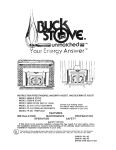
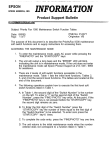
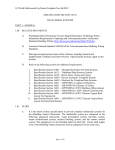

![Imprima este artículo - Poli[Papers]](http://vs1.manualzilla.com/store/data/006296209_1-1b337421890e8df5407f26e081d22ead-150x150.png)

